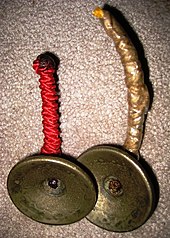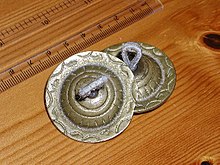cymbal

Zimbel , from Greek kymbalon to Latin cymbalum , and word formations derived from the same stem can denote several musical instruments or parts thereof:
- various idiophones consisting of circular bent metal plates or hollowed out metal vessels , with cymbals being used synonymously with small cymbals ,
- String instruments such as the zymbal (also zimbal ), a Hungarian dulcimer ,
- certain stops belonging to the organ and the mechanical organ mechanism Zimbelstern as well
- very small or pitch-high bells .
pool
The meaning of cymbal as an idiophone struck immediately can also be found in the English term cymbal , in French cymbale and in Italian cinelli . The latter corresponds to the German word Tschinellen . The cymbal spelling, which was also used in German in the past, is outdated.
history
The origin of the cymbals is related to the manufacture of bronze and is believed to be in China, India or the Middle East . In the Old Testament the musical instruments of the Israelite temple cult are mentioned several times in psalms , to which in addition to the two lyres ( kinnor and nevel) , drums (tuppim) , trumpets (chasosrah) , horns ( shofar ) , shaking idiophones made of clay (menaaneim) , rattles ( ?) (asey broschim) and cymbals (selslim or meziltajim) . In ancient Greece, the kymbala were metal basins that were occasionally used in the rituals for the goddesses Artemis , Athena and Persephone . The cymbalum (also tintinnabulum ) in Latin texts did not designate cymbals, but handbells, which were originally only used as signaling instruments in competitions.
Classification

Basins are defined according to the Hornbostel-Sachs system as "scalloped vascular rattles" and there form a subgroup of counter-strike idiophones, i.e. two self-sounding parts that are struck against one another. With "curved" are meant flat arched plates, which are differentiated from the bowl-shaped bodies, ie the "hollowed out vascular clasps". The pair pools , which are used in many cultures in light music and ritual music, can clearly be counted in the first group . These instruments are called hand cymbals because they are hit with both hands. The crotales (also antique cymbals ) represent a special form , which consist of a series of tuned circular flat bronze or brass plates. The second group of counter-strike idiophones includes smaller hollow forms such as the mostly wooden castanets, which are indispensable in Spanish dance music, or the iron qaraqib ( Sg.qarqaba ) played in the Maghreb .
According to the Hornbostel-Sachs system, the term cymbals only includes records played in pairs, regardless of their material. Outside of this classification, cymbals are nowadays understood to mean serve idiophones, more precisely those individually suspended metal plates struck with non-sounding tools such as mallets , brooms or hands, as well as the hi- hats attached to a stand in pairs and operated with a pedal for drums . The word cymbal has been narrowed down in German compared to the English cymbal , in that it is mainly used as a short form for hand cymbals (pair cymbals) or for very small cymbals that are attached to two fingers and are made of metal.
Hand cymbals
The cymbals played with both hands have a hump in the middle with a small hole or an eyelet through which a cord or leather strap is pulled to hold them. They are discussed in detail in the pair pool article .
Tingshas are small cymbals from the esoteric area associated with Tibet, which are connected to one another by a leather strap and which are tapped at the edges with both hands. In Tibetan music only the small, flat hunched cymbals sil sngan (sil-snyan) are played. Like practically all hand cymbals, they are held vertically.
Ceng-ceng are small bronze cymbals that are played in the gamelan of Java , Bali, and in the music of Lombok . Ching are the brass cymbals that keep the beat in Thailand . In the Mor Lam in the northeast of Thailand ( Isan ) and in Laos they accompany the mouth organ khaen in this function .
Large pools are not needed in India. In folk devotional songs ( bhajans ) , to accompany folk dances and in the chants of beggars, small cymbals connected with a string set the rhythm for the singer. The names of Indian cymbals vary from region to region: smaller ones are called manjira, jalra, jhallari, kartal , elathalam or kulittalam, larger cymbals are called jhanj, jhallari, brhattalam or brahmatalam . Bowl-shaped cymbals with a maximum diameter of five centimeters, which are called tal, taal, tali or talam , reveal their intended use by their name: Tala or talam denotes the rhythmic structure of Indian music .
Finger cymbals
With these small cymbals, it doesn't matter whether they are hollowed out or curved. After the game, they are also more accurate than finger cymbals (English finger cymbals called) and distinguished on the basis of their material from the non-metallic rattling. While hand cymbals can only be carried with procession music, the smaller finger cymbals and rattles, which can also be played in fast motion, are used in many oriental dances . Finger cymbals are usually played in four parts on the thumb and middle finger of both hands at the same time.
From the Maghreb to the Orient, there are numerous women's group dances that are performed for entertainment, at weddings and other festive occasions. Women's dances also play a major role in popular Islamic ceremonies. In Morocco and Tunisia, the dancers at the Derdeba and Stambali dance ceremonies create the rhythm with qaraqib , further east these iron rattles are replaced by cymbals, which in Egypt sagat ( sāǧāt ), in Turkey zil and in Iran and in southern Central Asia zang to be named. In Ottoman times dancers called çengi rattled with castanets (çarpara) , danced with finger cymbals, the women were called kâsebaz.
A special class of singers and dancers called ġawāzī (Sg. Ġāziya ), some of whom combined their profession with prostitution, performed in Egyptian cities in the 19th century at family celebrations and to entertain men in homes, and also at fairs on the occasion of the Pilgrimage together with fortune tellers and jugglers. In contemporary illustrations, they are seen with ṣāgāt in their hands and freely dressed. European travelers reported indignant about the immorality. In 1834, the Egyptian government banned these socially despised but often economically successful women from appearing in public streets. In contrast to the unveiled ġawāzī , the ʿawālim (Sg. ʿĀlima ) were considered to be decent and educated singers. They were also allowed access to the mansions, where they entertained the guests behind a partition wall for a high fee. Today, female dancers in Egyptian cities are indiscriminately referred to as ʿalma . Male dancers and ṣāgāt players who participate in tsar cults in Egypt are called abū ʾl-ġēt . The aim is to appease a predominantly female obsessive spirit. Each spirit is addressed with the music that is characteristic of it. In addition to men with ṣāgāt and the longitudinal flute nay , women play the frame drums mazhar and riq and the goblet drum darbuka .
In Korean culture , finger cymbals made of slightly curved brass or bronze used in entertainment dances are called tongbal . Larger hand cymbals (chabara) are used there in Buddhist ceremonies.
Stringed instruments
The European medieval dulcimer is shaped like a box zither , which was developed in the Middle East and is known as santur in Persian music . The cymbal (cymbalom) represents an enlarged further development in Hungary . The name of the harpsichord introduced into Renaissance music has the same origin.
In early Arabic literature, each type of basin is referred to as ṣandsch ( ṣandj , Pl. Ṣunūdsch ). The sources report that the word comes from Persian and that the instrument has been known since pre-Islamic times. Ṣanj, from Persian čang ( chang , bell, rattle) not only meant cymbals, but also harps . The meaning of kūba included both the Arabic drum ṭabl and the stringed instruments al-ʿūd and barbaṭ . In another case, an Arabic term denotes both wind instruments and string instruments. On the consonant root zmr go both reed instrument mizmar , and a stringed instrument called ZAMR (Pl. Zumūr ) back. In Arabic music, the names of the instruments are less based on the type of sound generation, but rather on their musical function. This makes it possible to explain the similarity of names to different types of instruments in the Arab world.
organ
An organ register with a high mixed part is called a cymbal . The Zimbelstern is an effect register for older or historically informed new organs. It consists of a ring of bells turning in a circle, from which it got its name.
Church bells
In campanology (bell science) very small and pitch-high church bells are called cymbals . The combination of several cymbal bells is called cymbal peal . Most of the time, cymbal bells are cast in extremely heavy ribs (wall thickness), especially when they complement a sounding set of chimes as a crown of sound. The dynamic balance thus achieved between the large bells and the cymbal bells is called rib progression.
Individual evidence
- ^ Herbert Gerigk : Technical dictionary of music. Keysersche Verlagsbuchhandlung, Munich o. J. (1966), p. 55, first published in 1954
- ↑ John Shepard et al. a. (Ed.): Continuum Encyclopedia of Popular Music of the World. Part 1. Performance and Production: Volume II: 2, Continuum, London 2003, p. 356, ISBN 978-0-8264-6322-7
- ↑ Joachim Braun: The music culture of old Israel / Palestine: Studies on archaeological, written and comparative sources. (Publications of the Max Planck Institute for History). Vandenhoeck & Ruprecht, Göttingen 1999, p. 97, ISBN 978-3-525-53664-3
- ^ Helmut Brand: Ancient Greek musical instruments. A brief overview. www.musikarchaeologie.de
- ↑ Alexander Buchner: Handbook of musical instruments. Werner Dausien, Hanau 1995, p. 61
- ↑ Bigamudre Chaitanya Deva, Josef Kuckertz : Bhārūḍ, Vāghyā-muralī and the Ḍaff-gān of the Deccan. Studies in the regional folk music of South India. (Ngoma. Studies on folk music and non-European art music, Volume 6) Musikverlag Emil Katzbichler, Munich / Salzburg 1981, p. 130
- ^ Anthony Baines: The Oxford Companion to Musical Instruments. Oxford University Press, Oxford 1992, p. 88
- ↑ Cymbals ... loved, hated and yet somehow indispensable. Bastet
- ^ Court Dance in the Ottoman Empire. Turkish Cultural Foundation
- ↑ Engel, pp. 254f, 259f; Marjorie Franken: From the Streets to the Stage. The Evolution of Professional Female Dance in Colonial Cairo. In: Paul Tiyambe Zeleza, Cassandra Rachel Veney (Eds.): Leisure in Urban Africa. Africa World Press, Trenton (New York) / Asmara 2003, pp. 87-92, ISBN 978-1-59221-062-6
- ^ Paul Collaer, Jürgen Elsner: North Africa . Series: Werner Bachmann (Hrsg.): Music history in pictures . Volume I: Ethnic Music. Delivery 8. Deutscher Verlag für Musik, Leipzig 1983, p. 34
- ↑ CE Bosworth et al. a. (Ed.): The Encyclopaedia of Islam. New Edition . Vol. IX, Brill, Leiden 1997, pp. 9f
- ↑ Hans Engel : The position of the musician in the Arab-Islamic area. Verlag for systematic musicology, Bonn 1987, pp. 132, 266f

